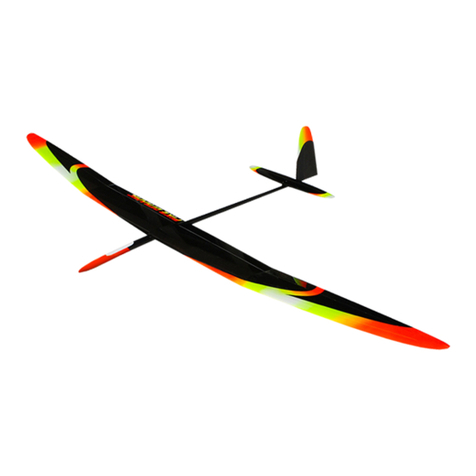
Assembling the wing:
1. Make and install the wing harness. The 9 pin plug can be secured both by screws or by a
silicone based glue. It is useful that this can be removed at a later time. Holes need to be
drilled between the midsection and tips for the harness. These holes shall be drilled between
the joiner pocket and the aft locater pin.
2. Roughen the surface of the servos and servo bay were the servo is to be glued.
3. Connect the servos and the fuse harness to the respective channels on the receiver. Check
that the aileron servo arms are set 90 degrees on the servo and that the transmitter also is
set to neutral. Check that the flap servo arms are set identically to approximately 20
degrees (measured from the 90°-angle) towards the flap. The transmitter should later be
set to an offset so that the flap servo arms are 90 degrees on the servo. With full down
landing flap the servo arms on the flaps are almost straight towards the flap. This ensures
full down deflection of the Flaps.
4. Check again the servo settings and also set the offset of the flap servos. Check also that the
servos move the right way.
5. Mark where the servo will be glued in place by a pencil in the servo trays and ensure that
the arm is aligned (straight line) to the hole in the sub spar and the surface horn. Some like
to glue the servo towards the spar. This ensures a very tight and slop free servo install
since the wing surface can bend a little.
6. Screw in the brass horns into the ready made holes in the surfaces. There is a nut glued
inside the surface for your convenience. Secure the nut with a tiny drop of thin CA.
7. Glue the servos in using epoxy. Use a proper amount of epoxy so that some epoxy is
pressed out on the side of the servo when you push them in. Use some weight fixing the
servos as long as the epoxy hardens to ensure that the servo fits perfect. If the epoxy is
thin it is possible to add some thixotropy agent (filler).
If your servos offer mounts, wrap the servo with some thin plastic, install them in their
mounts, then coat the entire bottom of the mount and twist into place to insure that the
epoxy ‘pots’ around the servo body and provides a good bond to the mount.
8. Size the linkage lengths so that the servo arm is 90 degrees on the servo when the surface
is in neutral. Secure the threaded linkage rod to the clevis with extra thin CA as this is a
place with some slop. Check also thoroughly the clevis pin that goes into the brass horn and
servo end, to insure that the fit is snug. Too tight is better than too loose when it comes to
the clevis pin to the horn or arm holes, a drop of CA there once the pin is in the arm or
horn, will insure a snug fit, but will still rotate once broke loose.
9. It is recommended to install clear tape on the adjoining ends of the midsection and tips.
This will prevent the paint from coming off when joining tape is applied / removed every
time you go flying.
10. Adjust the aileron throw to 14/13mm.
11. Adjust the aileron throw on flaps to 8/6mm
12. Adjust the landing flaps to as much down as possible (70-85 degrees)
13. Adjust the landing crow on ailerons to 6mm up
14. Adjust the camber for launch to 10mm flap and 2mm aileron down (measured on outer tip).
Camber for thermal/speed is +/- 3mm measured on flaps and equal along the whole trailing
edge.
15. Cut the servo covers carefully so that servo horn fit underneath the bumps.
Assembling the fuse:
1. Install the “fuse to wing”-harness in the fuselage
2. Install the fuse servos
3. Glue or solder the 2mm clevis couplers to the pushrods.
- To solder one need at least 75w soldering iron and some extra solder paste. Rub the
pushrods a bit to get the soldering easier. Check the soldering thoroughly.
- For gluing it is possible to put a smaller short pushrod steel wire inside the pushrod
tubing, install the clevis pushrod coupler and crimp it gently a side cutter. Secure with thin
CA. Sanding the surface of the pushrod also helps bonding. Check the connection
thoroughly.
4. Drill a hole on the side 5mm in front of the rudder hinge-line and just inside thru the rudder
post. From this hole pull antenna wire all the way inside to the front of the servo bay. This
wire should be soldered and secured with heat shrinking tube to the antenna wire of the
receiver. Pull the wire back and leave 40cm hanging out the end of the fuse.






















